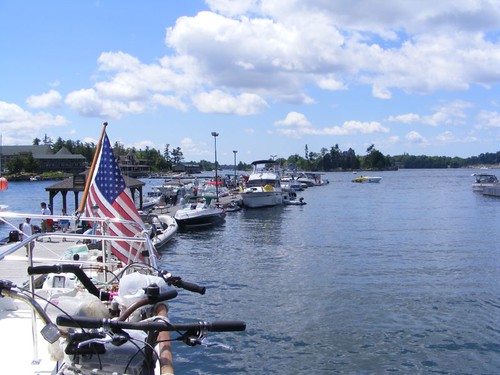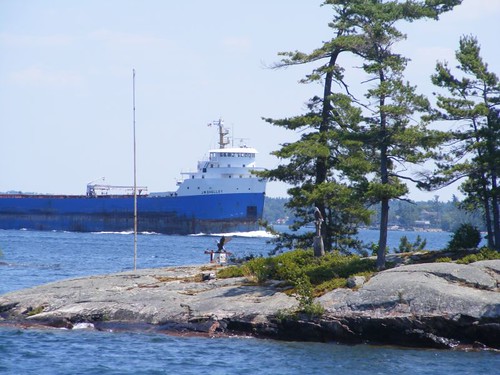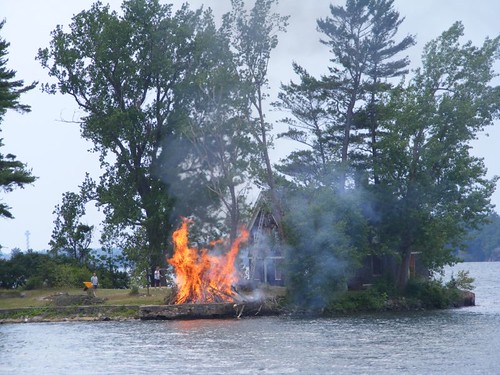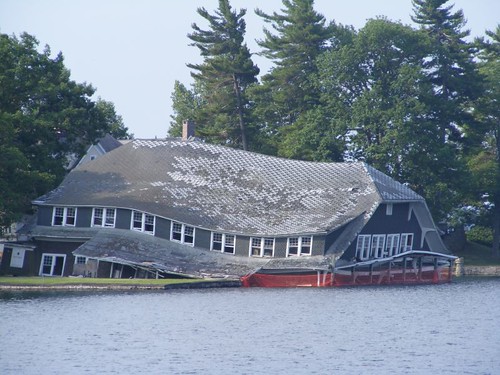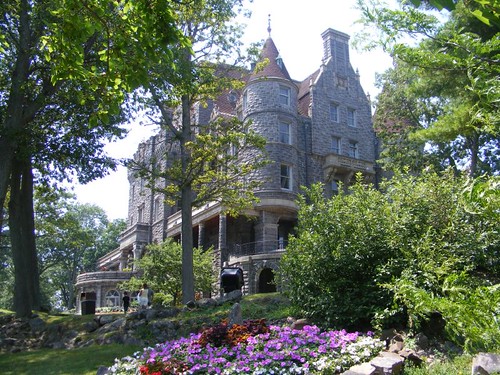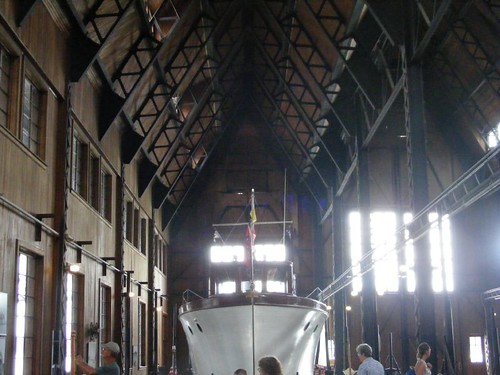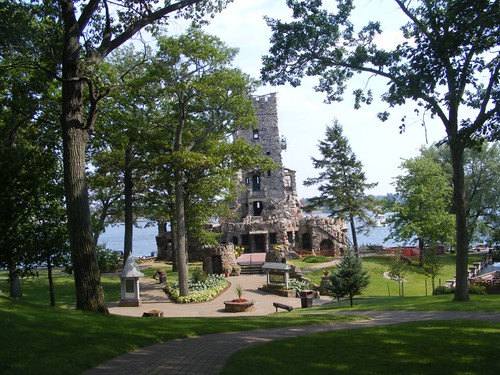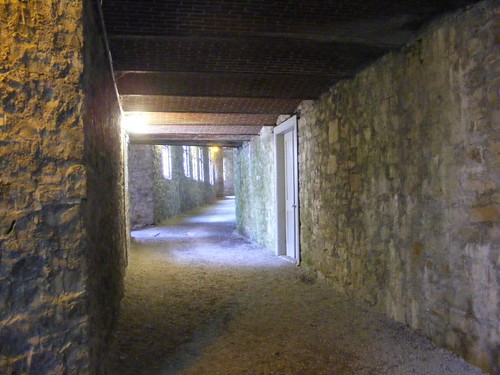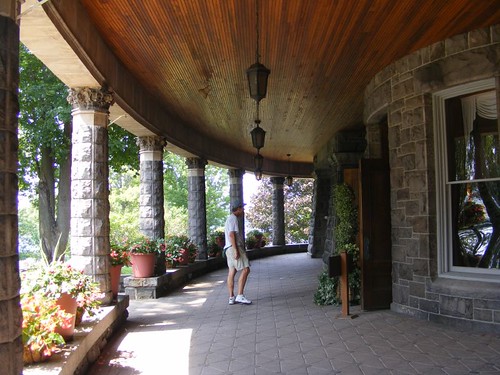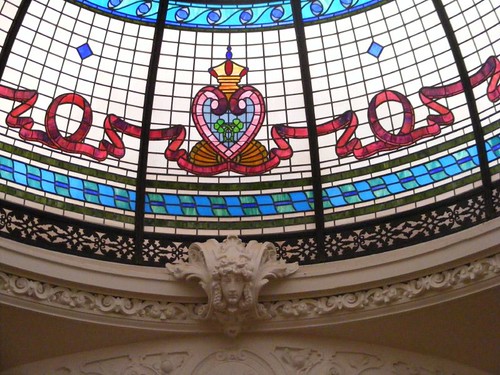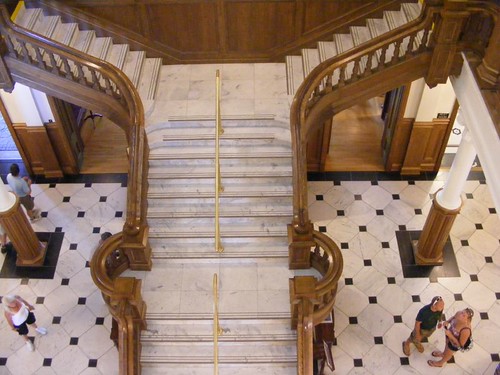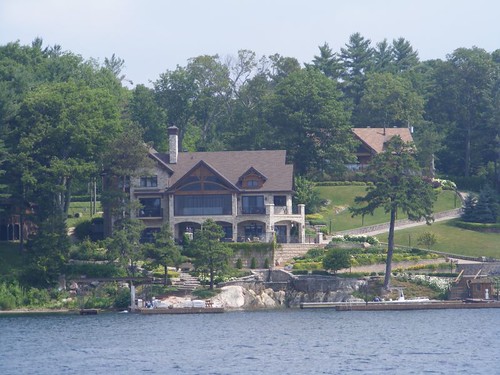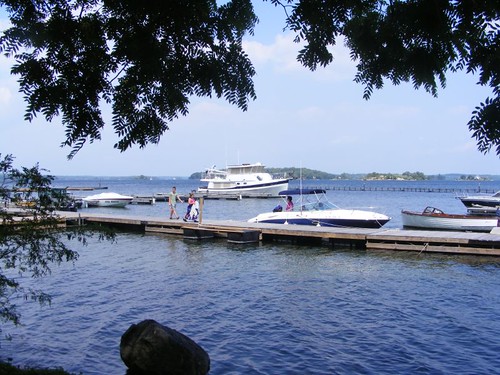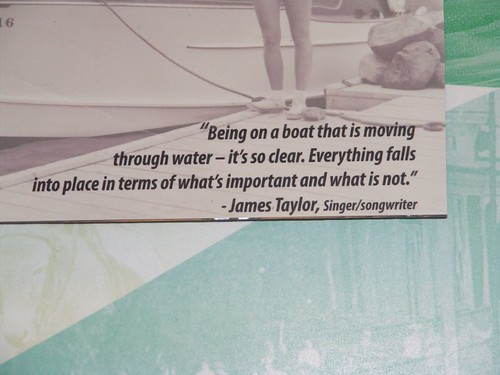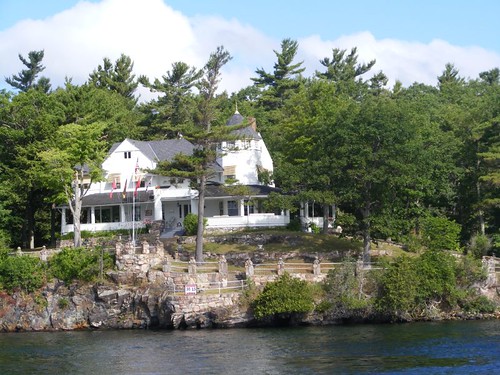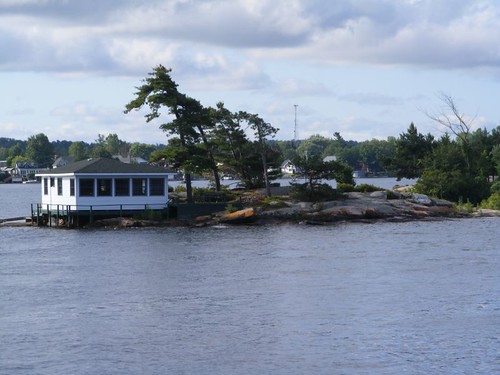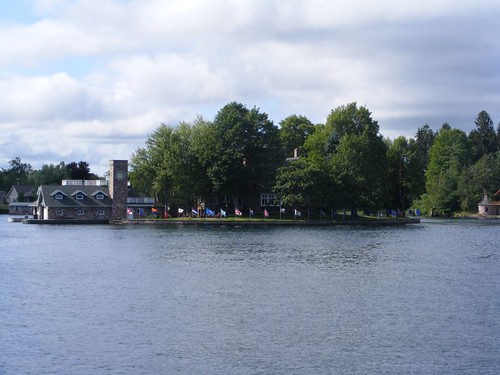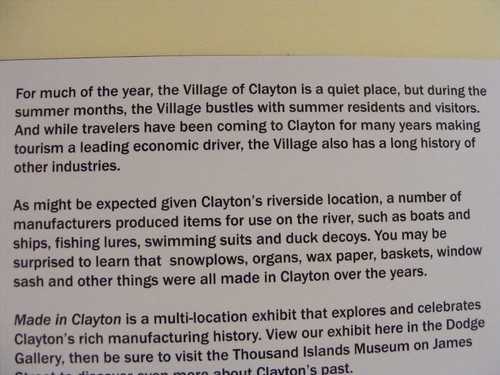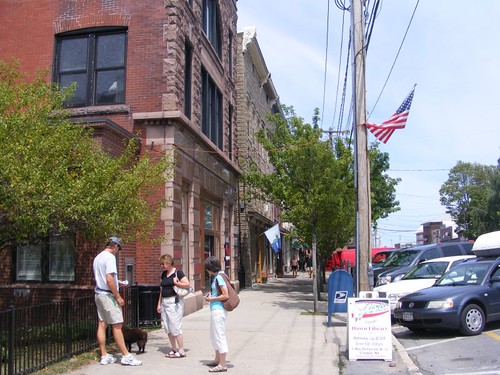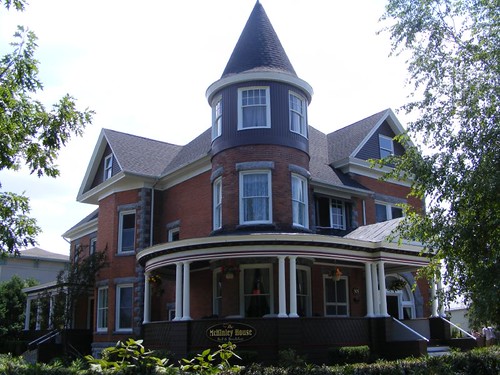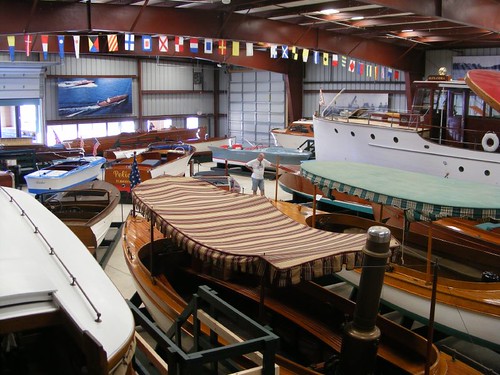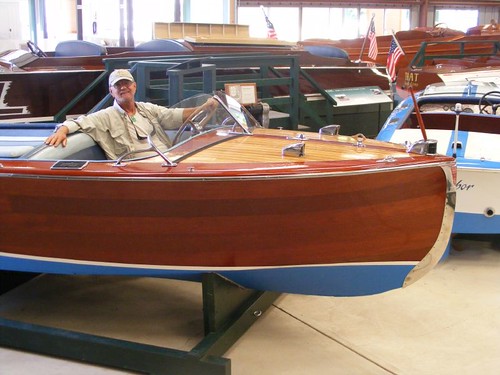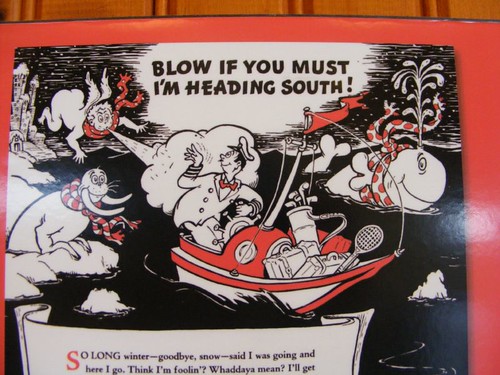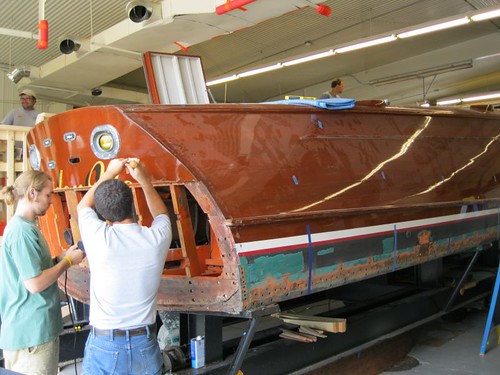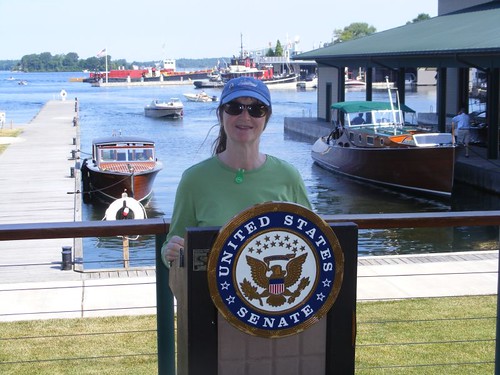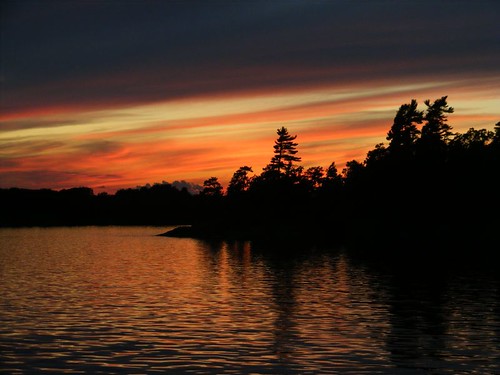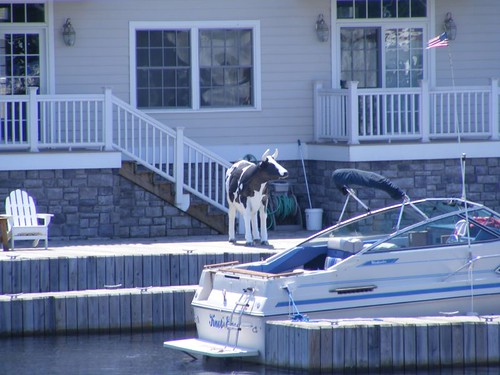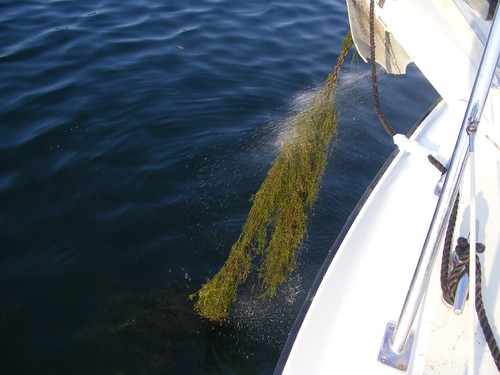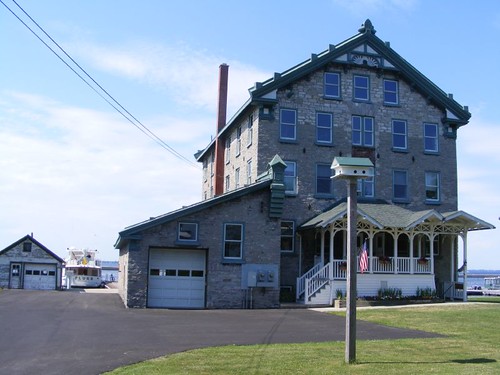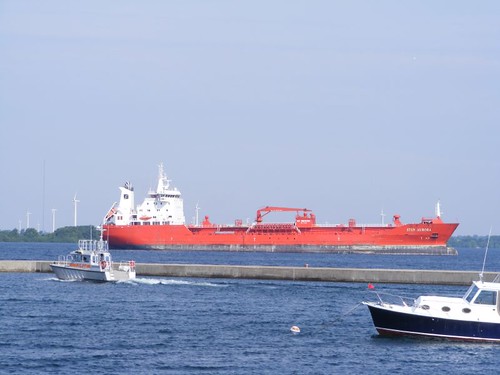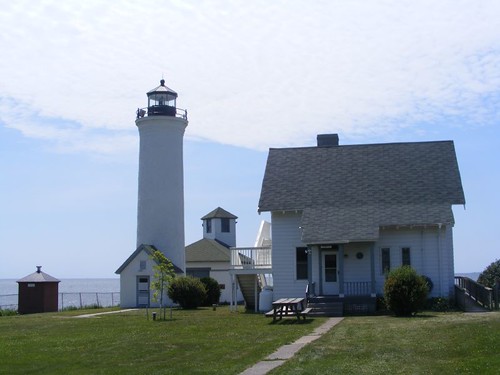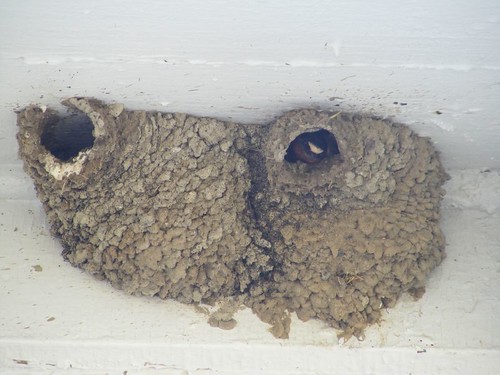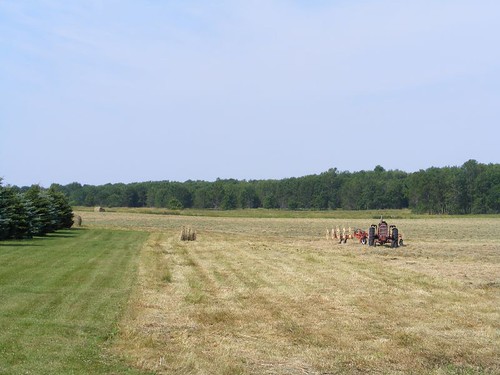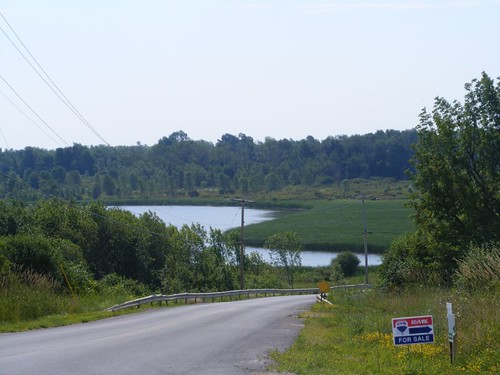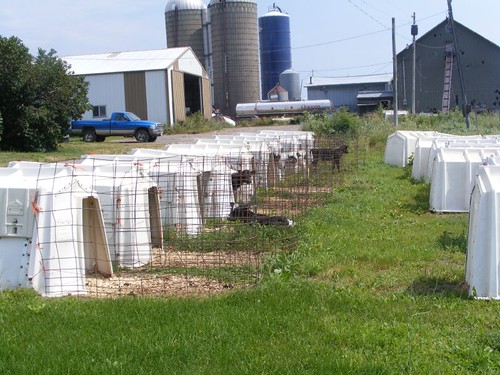July 8 – 14, 2011
After a wonderful day at the Antique Boat Museum in Clayton, we decided we would go back to anchor at Picton Island where we had anchored before. Without a care on the river, we dropped the Delta, just like the previous time, in almost the same spot. We couldn't get it to set then, or several other times. We even motored over to a nearby island where we knew some friends had anchored and tried there. Still no luck. So, we went all the way around the island, to the west side, and tried there. By this time, daylight was running out. We finally decided to try the Super Max anchor. After a couple of tries with that, we thought we were set OK, but we were only had 3-4' of water under us with only 70' of rope out, and not a lot of room to move if a storm blew up. That “maneuver” took almost 3 hours, with 13 tries at setting! We were not happy cruisers at that point. We are all snappy at each other, and there is no one to blame anything on.
There was a small boat tucked back in the cove, so we didn't think we had anything to worry about from it. A motoryacht came in and too quickly dropped an anchor; Eddie heard the guy at the helm tell the guy at the bow directing the anchor that their effort was “good enough”. While we didn't think it was, to make matters even more questionable, a sailboat came in shortly thereafter and rafted up to the motoryacht. I kiddingly remarked about what had happened the last time we were in an anchorage with two rafted boats (at Haverstraw Bay when they were washed up on shore). Another boat came in and halfheartedly dropped an anchor, but at least it was behind us and more out of the way.
At 11:00 p.m. the wind blew in like a freight train, in the opposite direction we (and everyone else) had set the anchor. Time for “all hands on deck” with the idea that we were sure to drag, along with the other boats. By some stroke of luck, and maybe because we really tried to make it work, our anchor held, but the two rafted boats were moving along at a good pace in our direction. Having all this going on in the dark is really no fun. It is very difficult to judge distance and direction because the boats are swinging back and forth with the gusting wind. We scrambled to get all our fenders on the side of the boat we thought they would hit. They came by close enough for us to be able to talk to them, but no boat contact was made as they were blown behind us. Then, they finally separated and we had to worry about them again as they tried to get past us going forward so they could get out of the cove altogether. The last boat that came in also dragged, but was well out of our way.
So, 3 out of the 5 boats ended up dragging. They were all lucky not to have ended up on the rocks. Now, you can see why we take the time to do the best job we can for the circumstances.
We pulled into the public dock at Alexandria Bay at 9:30 a.m., before the local “rush”. Alex Bay, as it is called by the river people, is just a party tourist town. It is nothing but restaurants, shops, marinas, and a place to board one of many tour boats that will take you out on the river to experience The Thousand Islands as they should be seen.
You can stay at the town dock for 4 hours for free, and then the charge is $1.50/ft. after that for the rest of the day. No overnight dockage is permitted. You only need the 4 hours to see the town, since it is really one street (not worth showing a photo), with only one building of historical significance. That time will allow you to shop, have lunch, and ogle boaters ogling your boat. From the photo, you can see day boats, not cruising boats like FLUKE. So, we draw a LOT of attention, especially when we try to leave the dock amidst all the congestion.
Ladies of the Alexandria Township Historical Society banded together to save this beautiful building from demolition in 1974. Since then, it has been placed in the National Registry of Historic Places and converted into a museum featuring artifacts, photos, and displays from the early days of Alexandria Bay and the St. Lawrence river communities. In the late 1800s, the general store, with its waterfront docks and accessibility to land functioned as an important economic and social focal point. The woman running the museum told me it was the “Walmart” of its day, supplying locals and tourists with their everyday needs. Plus, it is right across the river from, and has a premium view of, the biggest man-made draw to the region, Boldt Castle.
We planned a visit to the castle in a couple of days. First, we wanted to explore some more of the islands. When we were in Clayton, a friendly Canadian sailboat captain was kind enough to sit down with me and our chartbook and point out places that would be good for us to use as anchorages. So, we headed over to Sport Island, where we would spend a couple of nights in a sheltered setting.
We could watch the bulk cargo carriers on the St. Lawrence River. Many of them carry grain products like wheat and corn or petroleum products such as pitch, coal tar, and coal. One day we heard one of the tour boat captains call the captain of a cargo carrier saying that his passengers were wondering what the cargo ship was carrying. The captain, with a very pleasant tone, said that he was transporting wheat from Thunder Bay on Lake Superior to Quebec City. We thought that was pretty nice of him to offer all that information.
During the day, the anchorage filled up with day boaters, many of them rafting 6 boats across and a dozen groups of those. We are amazed at how they come into the anchorage at high rates of speed with no regard for anchored boats. I think they must live by the slogan “If you can't take the wake, get off the river”. Some of them are of the cigarette racing boat style that sound like jet engines, and you can hear them coming at 60 mph from a mile away. One particularly hideous one, a purple and orange rocket, came through the anchorage and the babe aboard was wearing a matching, hideous swimsuit the same colors as the boat! At least by night, they all left and we had the quiet place to ourselves.
There had been a couple of episodes of violent thunderstorm activity and localized tornadoes in the month preceding our arrival. We have seen a lot of damaged or uprooted trees on many islands. A couple of the islands in our anchorage area suffered tree damage, and we could see evidence of clean up activities in progress. When this trash pile near to where we were anchored got lit, it attracted a lot of river boaters to the area because the flames and smoke were visible from far away, and people probably thought one of the island homes was on fire.
We don't think that this big home's collapse was related to the recent storm activity. It was also near our anchorage and one of the tour boat routes, so it probably shows up in a lot of photos. It will probably get knocked down and replaced by a modern mansion if the economy ever improves.
We left the Sport Island anchorage early and arrived at Boldt Castle at 9:15 a.m., thinking that we should get there before everyone else so that we could get space at the outside of the dock, the only place we could fit. We knew that the castle opened at 10:00 a.m. When we pulled up to the dock we saw signs saying that the dock was closed from 7:00 p.m. - 10:00 a.m., but we tied up anyway. There were many workers getting started for the day, but no one came out and told us to go away.
As 10:00 rolled around, several other boats began pulling in. If you look in the photo you will see a long boat to the left of FLUKE. That is a rental houseboat. When it tried to pull into the dock the first time, it rammed the dock head on as the driver tried to turn the boat around. That obviously wasn't the first time the boat had been rammed by anyone as its pontoons were filled with dents. Eddie went over to help them and explained how to get the houseboat into the dock. When a woman aboard threw him the stern line to tie up, he tied up his end, but she never had hers tied up correctly, and the houseboat began drifting out. After the people left to go tour the castle, their bow line came off the dock, and the boat began drifting out again. Wayne got one of our long lines and jumped aboard the houseboat and threw me the line and we hauled the boat back to the dock and retied their lines. We didn't want that beast breaking loose and hitting FLUKE! It was finally time to start our tour.
George Boldt emigrated from Prussia in the 1860's with no money of his own, but through hard work, great imagination, and perseverance captured the American Dream when he became the most successful hotel magnate in America. He managed, and shared in the profits from, New York's Waldorf Astoria and Philadelphia's Bellevue-Stratton hotels.
In 1900, he began building Boldt Castle as a gift to his beloved wife, Louise. It was to be patterned after 16th century castles like those he saw and admired in the Rhineland region of Germany. No expense was spared. 300 workers labored for four years to build the ornate 6 story, 127 room castle with its own out buildings: yacht house, power house, dove-cote, Alster Tower “playhouse”, and waterway entry arch. In 1904 Louise died abruptly. George could not envision living in his dream castle without her, so he telegraphed that all work be halted immediately, and he never returned to the island.
From 1904 to 1977 the castle just deteriorated, subjected to the severe winters, vandals, and neglect. In 1977 The Thousand Islands Bridge Authority assumed ownership and began restoration work. Most of the rooms on the first and second floors have been completed and are decorated with furniture of the period donated by family descendants and other benefactors. It is estimated that in today's dollars, if George had completed the work, the Boldt Castle would have cost $70 million.
Once you pay for your admission ticket you are free to browse any of the buildings at your own pace, entering and leaving as you would like for the entire day. There are employees present in most of the furnished rooms and outbuildings to answer questions, but there are no organized tours. So, if you wanted to go picnic on another island or boat over to a restaurant you could take a break and come back again.
We started our tour at the Yacht House, accessed by a shuttle pontoon boat that leaves from the main dock, running every 30 minutes; we stayed an hour. The Yacht House is actually located on Wellesley Island and was used to house the family's three big yachts and the houseboat, La Duchesse I wrote about when we toured the Antique Boat Museum in Clayton. If you look at the photo, on the left, is their steamyacht, Kestral. Notice the different size doors to the house. They were built to accommodate each yacht, including a sailing ship, without having to take down any rigging.
The Yacht House is so unique and is filled with many antique boats, both sail and power, that were used in the Gilded Age of the Thousand Islands. You also can tour the Captain's Quarters, the round turret on the left side of the photo. The wood and stonework are fabulous.
When we got back to the main dock we decided to would visit the other outbuildings first since there was a threat of rain. If it started to rain, we could just move into the castle. The grounds are shaded with a mix of large pines and hardwoods with lots of small splashes of colorful flower beds. The first photo was from a huge bed of pansies on the grounds.
The Powerhouse looks like a small castle all by itself and is a real eye catcher from the river the way it sticks out off the end of the island. The Boldts intended to have electricity in the castle. Barges would bring diesel and gasoline to fire steam generators to make the power. The tallest tower was to have a clock and chimes for river traffic to enjoy.
You can enter the Power House up the stairs and over the arched bridge. There are old photos of some of the other properties George owned, notably his farms on nearby Wellesley Island which supplied numerous products to his hotels, thus insuring the freshest and best of everything for his guests.
This eccentric-looking mini castle was fully completed and used by the Boldt family when they were on the island during construction of the castle. They regularly entertained guests here, holding dances and plays and even had a two lane bowling alley down below. With many balconies, and sitting right on the river's bank, it provided great views of all river activities.
The extensive underground network of passages is really not a secret. They were built so that goods could be transported from barges to storage areas without accessing the main areas of the house. Even today you can see unused barrels of tiles that were packed in sawdust and shipped from Europe to be used in the castle construction. If you wind your way around long enough you may find the indoor swimming pool, built out of rock. A romanesque outdoor pool is adjacent to the Alster Tower, supplied with river water.
There are a number of sweeping, grand verandas, all with extensive wood and stone work. George incorporated several repetitive decorative designs in the wood, stone, and glass work that is used throughout the castle: hearts, clover leaves (his daughter was named Clover), and stags (his family's coat-of-arms).
This stained glass ceiling towers over the main entry hall and grand staircase. Notice the hearts and clovers.
The main staircase leads from the entry level up to the first floor living quarters, where the Boldt family's rooms (chambers, baths, and reception rooms) were to be located as well as a few (9) of the guest chambers.
By the time we got back to FLUKE at the Boldt dock, it was 6:15 p.m. We knew we didn't need to hurry since we were only going to go anchor about 500 yards away from the dock, between Belle and Wellesley Islands.
The water is pretty shallow and weedy, but we got the hook set and no volatile weather was predicted for the night. An older woman from a condo community next to where we anchored cheerfully yelled over and said “Do you want to park here?”, meaning at the condo dock. A group of the residents were standing nearby ogling FLUKE, so I guess they would have liked to be able to talk to us and hear about our adventures.
Shortly thereafter a young couple, Kate and Rob, yelled out “ahoy”. They were traveling in a little outboard boat, and were on the way to the grocery store over in Alex Bay and were curious about the boat. Kate had grown up with boats all her life, so had a lot of questions. While she was asking them, she decided to wipe down the scum line on our hull, so pulled her way around the whole boat. I suggested to Rob that she must have ADD; she never stopped talking or wiping the boat! Since it was getting dark and the mosquitoes were trying to come aboard I said good night and thanks for the wipe down and friendly conversation.
After we upped the anchor the next morning, we decided to take a scenic cruise over on the Canadian side of the river. We needed to stay close to Clayton since we had received word that our parts had arrived in the states and would be shipped to the village dock in Clayton.
It was apparent, there are quite a few Canadians that can also afford to have some spectacular waterfront homes with fabulous views of the waterway and picturesque islands.
We needed to find a new place to anchor or tie up for a night until our packages arrived in Clayton. Canoe Point State Park, located on Grindstone Island, faces the Canadian Channel that we were traveling in and one was of the places that we had marked on the charts that could fit FLUKE at their docks if the tee head was available. I looked through the binoculars and could see that there were no boats there, so we called the park and asked if there was enough water at the dock. They said that there was and we could go in.
Since we had gotten to the dock early in the day, we had plenty of time to go for a hike, down to Picnic Point, about 2 miles right along Eel Bay. Eddie decided to take a dip in a little cove with some nice rocks along the shore.
He was acting like Joe Cool, floating on his back and telling me how great the water felt, and that I should come in, until I looked over and saw a snake swimming right behind him. He scampered out of the water quicker than the snake swam in the opposite direction. We had seen several of those brown, nonvenomous water snakes, but I hadn't been able to get a picture.
On the way back to the boat, we stopped and picked wild black raspberries for our breakfast cereal. I wandered away from the guys and saw this weasel was standing up and peeking at me from behind the tree. I did the best I could to be able to get this shot with my camera without scaring it away.
Wayne spotted this big garter snake on the way back to the dock right before nightfall. Shortly after that, when we were all on the boat, a mink came running out all the way to the end of the dock peering into the water, probably looking for fish. Alas, it was too dark for me to get any pics, but we had a good time watching it until it jumped into the water and swam away. Cute little thing.
We were all raring to go the next morning since we were finally getting the parts. Clayton was only a short distance away, and this being the third time we were there, we knew how to safely get to the town dock.
As we were nearing the town, a U.S. Coast Guard boat hailed us on the radio and asked when was the last time we had been boarded by the USCG. I answered that we hadn't been boarded by the USCG, but we had been boarded by the Royal Bahamian Defence Force a couple of years ago. There was a hesitation on their end, and we could hear chuckling in the background when the guy came back on and said that that didn't count and that they wanted to board us. I told them we were on the way to the town dock and could they board then or did they want to board while we were bouncing around out of the river? They said they would meet us at the dock.
Three of them came aboard, and they were all very friendly and courteous. They conducted an overall safety inspection, but also had a lot of questions about our trip and FLUKE. They were very impressed with how neat and orderly Eddie keeps the engine and machinery rooms down below; an orderly ship is a safe ship. We were cited with two violations: our life ring wasn't hung in a proper place and our sewer discharge line wasn't locked down. Since we seemed like nice people and had everything else in order, the unit leader said he wouldn't give us a ticket if we immediately took care to fix the violations. Since they were all animal lovers and were fascinated with Ursa, I let her entertain them with several of her tricks.
Right after they left, a terrible thunderstorm moved in, with a squall line of high winds hitting the town dock broadside, with us on the outside. Wayne spotted the UPS truck on the street and ran to see if our packages were aboard. He got wet carrying them back to the boat, but at least we had them aboard before the winds really ramped up. Our fenders were getting crushed, and we were worried that the hull would get pushed right up against the dock and scraped up. Water was being blown up onto the dock. A sailboat berthed on the inside of the dock had a stern line snap, and Eddie rushed over to help secure the boat before it could swing into boats berthed on the adjacent dock. It was chaos! Fortunately it didn't last long and we left the dock under calm winds.
We spent our last 2 nights in the U.S. back at the east side of Picton Island, tucked up in the cove with our anchor set firmly in place waiting for whatever kind of weather Mother Nature wanted to send our way before we checked into Canada.
Tuesday, July 26, 2011
Sunday, July 17, 2011
Getting a Feel for The Thousand Islands
July 7 – 8, 2011
From Cape Vincent we planned to travel northeast down the St. Lawrence River to the area of Clayton, NY, only about 16 miles. We were still hoping that we would receive news that the parts we were waiting for from Holland had arrived in the country (Maine) and could be shipped to us while we were still in the U.S. Our plan was to cross the international border only once, so we wanted to see all the sights on the U.S. side before heading over into Canadian waters.
The area around Clayton is where the Thousands Islands mostly begin. Indians called the Thousand Islands Manitoanna, meaning the “Garden of the Great Spirit”. It is easy to see how they came up with that name when you see the unique shapes from the rocks and tree lines adjacent to the clear, blue water.
The 1800 islands in the St. Lawrence River are either U.S. or Canadian, none are shared by both. The peaceful border is the world's longest unfortified border, in effect since the end of the War of 1812. Nautical charts clearly show the very crooked division line; you can travel underway on either side of the line without clearing customs as long as you don't fish, anchor, or go ashore. Some of the islands are so close you could easily swim from one country to the next.
You cannot get the feel for, nor understand, what the Thousand Islands are all about, unless you get out on the water. There are public tour boats of all sizes, private rental boats and guides, and lots of places to dock or anchor your own boat. Several of the 45 New York and Canadian State Parks of the Thousand Islands are accessible only by boat, and they are really well-used during the busy summer months. A LOT of people, from both sides of the border, take their boats out on the weekends and “camp” out at park docks or at anchorages. They set up little grills for cooking, swim in the cold water, and lay out in the sun all day. Most of them travel with very fast, noisy boats. We stick out like sore thumbs! However, most everyone has been very kind and inquisitive about FLUKE and our adventure.
Once out on the water you will notice two things: the sizes of the islands and the sizes of the homes on the islands. Some of the islands are so small you could barely find room to park your car, but there may be a small “house” on it anyway. Other islands are large enough to accommodate several expensive homes without feeling crowded or one large private castle, depending on how many rooms are needed to entertain guests. Many of them have boathouses and extensive docks. A lot of them used native stones for building parts of the houses and elaborate walls and terraces. Then you need to realize, that most all of the island homes are used on a seasonal basis only! During the winter months, the waters are frozen over, so getting to the islands by boat is out of the question. Some islands could be driven to by car or snowmobile, but it is too chancy to count on having solid accessibility.
Some of the tour boats not only travel along the St. Lawrence River, but also weave in and out of many small island areas, giving the patrons a real chance to see the beauty of the islands. Plus, they also point out the noteworthy homes and talk about their original owners. Many of the large estates were built in the 1800s for corporate magnates so they could get away from the hustle bustle of the city and entertain their guests in the wilderness, but still have the comforts of home. A lot of those people came to the islands for hunting and fishing and developed elaborate summer social networks of sports: boat racing and showing, golf, and tennis. “Common” people began visiting the islands when tour steamships became popular and hotels sprang up along the mainland to house the new tourists to the area.
Clayton is a great place to get introduced to life in the Thousand Islands. The village offers several public docking areas with easy access from the river. We tied up at the Clayton Town Dock midday, right next to the Antique Boat Museum, which we planned to tour the following day.
The main tourist area, two streets, has the requisite number of ice cream shops, restaurants, and tourist boutiques. There aren't a lot of historic buildings, but those that are present are all occupied; the area is bustling with activity. Learn about the history of the Thousand Islands by visiting the small, Thousand Islands Museum. Since there is a minimal tree canopy the street area away from the waterfront was pretty hot since the buildings blocked the cool air blowing off the river. You can book a tour of the river from a waterfront tour operation.
This beautiful Bed and Breakfast is located right in town and would be a great place to access anything you wanted to visit in the area.
This quiet lady was standing outside the Thousand Islands Arts Center. Being a true Thousand Islander, I imagined she would agree with the following:
That little bit of history came from one of the displays at the Antique Boat Museum, where we spent an entire day and thought we could probably spend some more time. There is so much to see in any of the 8 buildings. You are given an education of early (small rowing and sailing vessels) river boat history through the invention of the steam and gasoline engines.
We started our day with a guided tour of La Duchesse. This 106' 1903 houseboat from the Gilded Age was owned by George Boldt, of the Boldt Castle fame, that we would visit in a few days. The photo is a photo of an oil painted fireplace screen aboard the boat. I thought it captured the elegance of the boat in an appropriate setting for its original use. Mr. Boldt summer island hopped with the houseboat, towing it from island to island with a tugboat, another of his many boats in his private fleet of dozens of all kinds of vessels. The houseboat is filled with gleaming woods with intricate carvings and polished metal fixtures. Rooms are set up with furniture and furnishings from the day.
The Cleveland E. Dodge building treats you to a plethora of classic motorized pleasure boats: launches, utility boats, and overnight cruisers. They all have a story to tell and you can't help but be amazed by their beauty; you can see your reflection in all the hulls and dream about what an exciting life they had and marvel in their preservation. Thanks to all the generous donors who gave the boats to the museum for the enjoyment of so many.
Most parts of the museum are self-guided, so you walk around at your own pace. As in this photo, a couple of the exhibits are hands-on, so you can board the vessel and fantasize about life on the river in a classic boat. If you want a real speed thrill, you can even take a boat ride in a triple-cockpit runabout for 45 minutes through the islands. We saw the museum boat out on the river many times with people holding on to their hats and their hair blowing behind them.
We learned that Standard Oil Corp. used the character of Dr. Seuss to promote their marine oils once the age of the gasoline engine emerged. Everyone could relate to the clever lyrics and artwork.
The gasoline engine allowed boaters to move around more quickly, with day trips, and even seasonal trips. They no longer had to worry about getting blown in the wrong direction by the wind or rowing against currents. They could go anywhere at any time!
The museum received a grant to help educate children about sailing. Every time we went by the waterfront there were kids out in the colorful little Sunfish sailboats. Adults can get some hands-on activity by going out on the water in St. Lawrence rowing skiffs as part of the admission to the museum.
The museum employees are all very approachable and gladly answer questions about the exhibits and the projects they may be working on. We spent quite a while talking to the people working in the Boat Restoration Shop on the world famous runabout, PARDON ME. She will undergo hours of slow, painstaking wood working and mechanical restoration to bring her back to the life for which she was originally built.
The day we were at the museum, one of the U.S. Senators from NY was going to be giving a press conference dealing with an “incident” that had recently occurred in the Thousand Islands. A charter U.S. fishing captain had been fishing in Canadian waters, with a Canadian fishing license, but didn't clear customs, as he had NEVER done before. It is easy to just drift back and forth over the border lines. Canadian border agents apprehended him and fined him $1000 or threatened to take his boat. We still haven't heard how the ruckus has been finalized. Anyway, we saw the podium had been set up and people were all nerved out about the Senator's arrival, so we decided to have a little fun of our own. Right after the press conference ended, the aid went to the podium and removed the “official seal”, which was just held on with velcro. That's about how solid our government is now anyway!
We decided to spend our first night at anchor at Picton Island, just across the river from Clayton. We set the hook on the first try and settled in to enjoy the lovely scenery and cool river breezes. Little did we know that our first anchoring effort was just a “fluke” and what troubles would lie ahead.
From Cape Vincent we planned to travel northeast down the St. Lawrence River to the area of Clayton, NY, only about 16 miles. We were still hoping that we would receive news that the parts we were waiting for from Holland had arrived in the country (Maine) and could be shipped to us while we were still in the U.S. Our plan was to cross the international border only once, so we wanted to see all the sights on the U.S. side before heading over into Canadian waters.
The area around Clayton is where the Thousands Islands mostly begin. Indians called the Thousand Islands Manitoanna, meaning the “Garden of the Great Spirit”. It is easy to see how they came up with that name when you see the unique shapes from the rocks and tree lines adjacent to the clear, blue water.
The 1800 islands in the St. Lawrence River are either U.S. or Canadian, none are shared by both. The peaceful border is the world's longest unfortified border, in effect since the end of the War of 1812. Nautical charts clearly show the very crooked division line; you can travel underway on either side of the line without clearing customs as long as you don't fish, anchor, or go ashore. Some of the islands are so close you could easily swim from one country to the next.
You cannot get the feel for, nor understand, what the Thousand Islands are all about, unless you get out on the water. There are public tour boats of all sizes, private rental boats and guides, and lots of places to dock or anchor your own boat. Several of the 45 New York and Canadian State Parks of the Thousand Islands are accessible only by boat, and they are really well-used during the busy summer months. A LOT of people, from both sides of the border, take their boats out on the weekends and “camp” out at park docks or at anchorages. They set up little grills for cooking, swim in the cold water, and lay out in the sun all day. Most of them travel with very fast, noisy boats. We stick out like sore thumbs! However, most everyone has been very kind and inquisitive about FLUKE and our adventure.
Once out on the water you will notice two things: the sizes of the islands and the sizes of the homes on the islands. Some of the islands are so small you could barely find room to park your car, but there may be a small “house” on it anyway. Other islands are large enough to accommodate several expensive homes without feeling crowded or one large private castle, depending on how many rooms are needed to entertain guests. Many of them have boathouses and extensive docks. A lot of them used native stones for building parts of the houses and elaborate walls and terraces. Then you need to realize, that most all of the island homes are used on a seasonal basis only! During the winter months, the waters are frozen over, so getting to the islands by boat is out of the question. Some islands could be driven to by car or snowmobile, but it is too chancy to count on having solid accessibility.
Some of the tour boats not only travel along the St. Lawrence River, but also weave in and out of many small island areas, giving the patrons a real chance to see the beauty of the islands. Plus, they also point out the noteworthy homes and talk about their original owners. Many of the large estates were built in the 1800s for corporate magnates so they could get away from the hustle bustle of the city and entertain their guests in the wilderness, but still have the comforts of home. A lot of those people came to the islands for hunting and fishing and developed elaborate summer social networks of sports: boat racing and showing, golf, and tennis. “Common” people began visiting the islands when tour steamships became popular and hotels sprang up along the mainland to house the new tourists to the area.
Clayton is a great place to get introduced to life in the Thousand Islands. The village offers several public docking areas with easy access from the river. We tied up at the Clayton Town Dock midday, right next to the Antique Boat Museum, which we planned to tour the following day.
The main tourist area, two streets, has the requisite number of ice cream shops, restaurants, and tourist boutiques. There aren't a lot of historic buildings, but those that are present are all occupied; the area is bustling with activity. Learn about the history of the Thousand Islands by visiting the small, Thousand Islands Museum. Since there is a minimal tree canopy the street area away from the waterfront was pretty hot since the buildings blocked the cool air blowing off the river. You can book a tour of the river from a waterfront tour operation.
This beautiful Bed and Breakfast is located right in town and would be a great place to access anything you wanted to visit in the area.
This quiet lady was standing outside the Thousand Islands Arts Center. Being a true Thousand Islander, I imagined she would agree with the following:
That little bit of history came from one of the displays at the Antique Boat Museum, where we spent an entire day and thought we could probably spend some more time. There is so much to see in any of the 8 buildings. You are given an education of early (small rowing and sailing vessels) river boat history through the invention of the steam and gasoline engines.
We started our day with a guided tour of La Duchesse. This 106' 1903 houseboat from the Gilded Age was owned by George Boldt, of the Boldt Castle fame, that we would visit in a few days. The photo is a photo of an oil painted fireplace screen aboard the boat. I thought it captured the elegance of the boat in an appropriate setting for its original use. Mr. Boldt summer island hopped with the houseboat, towing it from island to island with a tugboat, another of his many boats in his private fleet of dozens of all kinds of vessels. The houseboat is filled with gleaming woods with intricate carvings and polished metal fixtures. Rooms are set up with furniture and furnishings from the day.
The Cleveland E. Dodge building treats you to a plethora of classic motorized pleasure boats: launches, utility boats, and overnight cruisers. They all have a story to tell and you can't help but be amazed by their beauty; you can see your reflection in all the hulls and dream about what an exciting life they had and marvel in their preservation. Thanks to all the generous donors who gave the boats to the museum for the enjoyment of so many.
Most parts of the museum are self-guided, so you walk around at your own pace. As in this photo, a couple of the exhibits are hands-on, so you can board the vessel and fantasize about life on the river in a classic boat. If you want a real speed thrill, you can even take a boat ride in a triple-cockpit runabout for 45 minutes through the islands. We saw the museum boat out on the river many times with people holding on to their hats and their hair blowing behind them.
We learned that Standard Oil Corp. used the character of Dr. Seuss to promote their marine oils once the age of the gasoline engine emerged. Everyone could relate to the clever lyrics and artwork.
The gasoline engine allowed boaters to move around more quickly, with day trips, and even seasonal trips. They no longer had to worry about getting blown in the wrong direction by the wind or rowing against currents. They could go anywhere at any time!
The museum received a grant to help educate children about sailing. Every time we went by the waterfront there were kids out in the colorful little Sunfish sailboats. Adults can get some hands-on activity by going out on the water in St. Lawrence rowing skiffs as part of the admission to the museum.
The museum employees are all very approachable and gladly answer questions about the exhibits and the projects they may be working on. We spent quite a while talking to the people working in the Boat Restoration Shop on the world famous runabout, PARDON ME. She will undergo hours of slow, painstaking wood working and mechanical restoration to bring her back to the life for which she was originally built.
The day we were at the museum, one of the U.S. Senators from NY was going to be giving a press conference dealing with an “incident” that had recently occurred in the Thousand Islands. A charter U.S. fishing captain had been fishing in Canadian waters, with a Canadian fishing license, but didn't clear customs, as he had NEVER done before. It is easy to just drift back and forth over the border lines. Canadian border agents apprehended him and fined him $1000 or threatened to take his boat. We still haven't heard how the ruckus has been finalized. Anyway, we saw the podium had been set up and people were all nerved out about the Senator's arrival, so we decided to have a little fun of our own. Right after the press conference ended, the aid went to the podium and removed the “official seal”, which was just held on with velcro. That's about how solid our government is now anyway!
We decided to spend our first night at anchor at Picton Island, just across the river from Clayton. We set the hook on the first try and settled in to enjoy the lovely scenery and cool river breezes. Little did we know that our first anchoring effort was just a “fluke” and what troubles would lie ahead.
Thursday, July 14, 2011
FLUKE and the Big O
July 4 – 6, 2011
With the weather forecast we had in hand, we didn't think that the rougher waters we encountered leaving Oswego would persist, but they did for most of the 5 hours it took us to reach another protected harbor. As usual, under these conditions, Visitor threw up. At about the same time, a watermelon I had in a basket on an end table got thrown out and cracked open on the floor. So, I had a lot to clean up down below, never a good place for any of us to be when we are getting bounced around.
Our destination for the late afternoon was Sackets Harbor, along the southeastern shore of Lake Ontario. From now on, we would have to rely on our charts, cruising guides and reports from other cruisers as to where we could safely anchor or tie up; we had never traveled in these parts before, by sea or by land. One peek into the harbor, and we knew the place wasn't for us. The marina was packed full of boats, and the tiny harbor was way to small for a boat like FLUKE. We said a quick hello and goodbye to this Holstein cow on a condo dock and headed back to sea.
We had to back track 5 miles to Henderson Harbor, and we ended up dropping our anchor in a little protected spot called White's Bay. There was plenty of water for us and good wind protection. A lot of day boaters were out making a lot of noise and wakes, but as soon as the sun set, they all went to their docks. Many of the lakeside communities had fireworks that night, so it was interesting to see all the displays in the distance.
When we hauled up the anchor in the morning, the chain was filled with aquatic weeds, the most we had ever seen. It took a long time to get the weeds off; we couldn't let all that plant material go into the chain locker and turn into stinking rot. We would learn that the weeds were to be the norm, and would cause us many more anchoring moments of aggravation.
Our destination for the late morning of July 5 was Cape Vincent, NY. The free town dock space was taken up by broadly spaced small boats, but there was room for us at the New York State Department of Environmental Conservation/Cape Vincent Fisheries Station's dock. I thought it amusing that a boat named FLUKE was at a fishery dock.
The attractive 1865 building was originally constructed as a grist mill. As early as 1895 it was converted for use as a fish hatchery. Today it serves as a base for aquatic resource and fisheries research and protection.
This cute research vessel is based out of the DEC facility and would go out from 7-5 daily and be berthed next to us for the evening. The DEC allows pleasure craft 48 hours of free dockage in the unused dock space once built for other DEC vessels, which are no longer berthed at the Cape Vincent facility.
CV Fisheries Station maintains an aquarium and visitors information center for educational purposes in the basement of the building. Its purpose is to provide information about the species of fish common to Lake Ontario and the St. Lawrence River. Live species of native fish are on display, with information about their ecology. Invasive species are showcased as preserved specimens. The zebra mussels display talks about how effective the zebra mussels have been in helping clean up the waters Great Lakes where they have become established because they filter enormous amounts of water, eliminating the turbidity. This has allowed aquatic vegetation, both native and invasive, to propagate and clog waterways and harbors where a problem had not previously existed.
The research facility describes fisheries programs designed to protect delicate species, such as the sturgeon which were almost brought to extinction in the lakes and river. The free aquarium is open daily, and you can walk around at your own pace. The grounds are also a park with picnic tables and restrooms, so pack a lunch and make a day of it visiting the wonderful village of Cape Vincent.
Ship watching is a favorite attraction for visitors. We could see the big, sea-going bulk cargo carriers (grains, coal tar, coal pitch) going right by where we were docked. In this photo, a pilot boat is headed out to drop off a captain that will guide the foreign-registered ship up the St. Lawrence River. You can also see the giant windmills, part of an 86 unit wind farm located on the Canadian island across the river, Wolfe Island. Also, notice the big breakwater between us and the river, designed to keep the big ship wakes from damaging the docking areas.
There is only one ferry that crosses the entire St. Lawrence River, and it goes from Wolfe Island to Cape Vincent and back from May to October, running back and forth continuously all day long, about a 30 minute ride. Another ferry connects Wolfe Island to the big, historic city of Kingston, Ontario, Canada. We watched the ferry cross many times carrying all kinds of vehicles: cars, boats, motorcycles, and bicycles. When I tried to take the photo, a U.S. Customs Border Patrol Agent reprimanded me for going beyond the “proper” boundary, whatever that is supposed to mean, since there weren't any obvious signs. I think there was some concern I might try to mingle with people coming off the ferry before they cleared customs. With 30 million illegal aliens in this country already, this seemed extreme. Not that I said that to the agent, though!
Cape Vincent's tourist slogan is “Where the Lake and River Meet”, and that is best exemplified by the Tibbetts Point Lighthouse, circa 1827. It sits right outside of town on the peninsula of land where Lake Ontario meets the St. Lawrence River, so it played a prominent role in history of providing safe navigation for all kinds of ships and watercraft. In this photo you can the lighthouse, a smaller sound making building, and the keepers house, now an overnight hostel for bicyclists and good place for swallows to build their mud nests!
We rode our bicycles out to the lighthouse, a great 3 mile riverside ride since the lighthouse is the end of the road, so there is minimal vehicular traffic. It was a good opportunity to see the town and the river views.
Cape St. Vincent was a bustling community by the late 1800s, mostly deriving prosperity from farming and the river trade industry. It has a strong French heritage because many evacuees and military veterans from the French Napoleonic war settled in the area. In fact, property was acquired for Napoleon to live in if he could be rescued from St. Helena. The French influence is noticed by family names and architectural styles, particularly the use of stone like was seen in the DEC photo. Several, beautiful private residences use stone construction with European detailing. The little Cape Vincent Historical Museum is housed in one of the oldest stone buildings in town and was used as a barracks for soldiers during the War of 1812.
The village is so quaint and really beautiful. The main street has a few, low key shops and restaurants, but they blend in to the feel of the old village. The residential neighborhood of modest, but well-kept homes sits behind the main street, on a gently sloping hill, so if you walk to the end of the street you can see down to the river. Several of the streets that end at the river provide public access, including having a couple of benches where people can sit to watch river activities. Trees and flowers are abundant; there can never be too many of them in my opinion.
We spent an afternoon on another 3 mile bike loop that took us to the outlying farming areas. It is hay baling time, and what I can't capture in the photo is the glorious smell of this freshly cut hay field. It was the perfect time to stop to catch my breath after trying to peddle up another too steep hill.
Our goal was to get to this overlook, where an inlet jutted in from Lake Ontario southwest of town. We were surprised to see all the marsh land down the hill adjacent to the water. When we made the turn and were riding the crest of the hill above the marsh, there were old apple orchards, more hay fields, and dairy farms, and even a goat farm.
In front of one of the dairy farms, they had a whole row of these calf houses going right out to the road. When we stopped the cute little calves started mooing and came out of their houses to check us out. Eddie and I wanted to go pet them, but figured it would cause a ruckus, either with the calves or the farmer, or both.
Cape Vincent turned out to be one of my favorite ports so far, and it would have been easy to think about spending another day or two. However, the St. Lawrence was flowing quickly and would serve well to move us to our next destination.
With the weather forecast we had in hand, we didn't think that the rougher waters we encountered leaving Oswego would persist, but they did for most of the 5 hours it took us to reach another protected harbor. As usual, under these conditions, Visitor threw up. At about the same time, a watermelon I had in a basket on an end table got thrown out and cracked open on the floor. So, I had a lot to clean up down below, never a good place for any of us to be when we are getting bounced around.
Our destination for the late afternoon was Sackets Harbor, along the southeastern shore of Lake Ontario. From now on, we would have to rely on our charts, cruising guides and reports from other cruisers as to where we could safely anchor or tie up; we had never traveled in these parts before, by sea or by land. One peek into the harbor, and we knew the place wasn't for us. The marina was packed full of boats, and the tiny harbor was way to small for a boat like FLUKE. We said a quick hello and goodbye to this Holstein cow on a condo dock and headed back to sea.
We had to back track 5 miles to Henderson Harbor, and we ended up dropping our anchor in a little protected spot called White's Bay. There was plenty of water for us and good wind protection. A lot of day boaters were out making a lot of noise and wakes, but as soon as the sun set, they all went to their docks. Many of the lakeside communities had fireworks that night, so it was interesting to see all the displays in the distance.
When we hauled up the anchor in the morning, the chain was filled with aquatic weeds, the most we had ever seen. It took a long time to get the weeds off; we couldn't let all that plant material go into the chain locker and turn into stinking rot. We would learn that the weeds were to be the norm, and would cause us many more anchoring moments of aggravation.
Our destination for the late morning of July 5 was Cape Vincent, NY. The free town dock space was taken up by broadly spaced small boats, but there was room for us at the New York State Department of Environmental Conservation/Cape Vincent Fisheries Station's dock. I thought it amusing that a boat named FLUKE was at a fishery dock.
The attractive 1865 building was originally constructed as a grist mill. As early as 1895 it was converted for use as a fish hatchery. Today it serves as a base for aquatic resource and fisheries research and protection.
This cute research vessel is based out of the DEC facility and would go out from 7-5 daily and be berthed next to us for the evening. The DEC allows pleasure craft 48 hours of free dockage in the unused dock space once built for other DEC vessels, which are no longer berthed at the Cape Vincent facility.
CV Fisheries Station maintains an aquarium and visitors information center for educational purposes in the basement of the building. Its purpose is to provide information about the species of fish common to Lake Ontario and the St. Lawrence River. Live species of native fish are on display, with information about their ecology. Invasive species are showcased as preserved specimens. The zebra mussels display talks about how effective the zebra mussels have been in helping clean up the waters Great Lakes where they have become established because they filter enormous amounts of water, eliminating the turbidity. This has allowed aquatic vegetation, both native and invasive, to propagate and clog waterways and harbors where a problem had not previously existed.
The research facility describes fisheries programs designed to protect delicate species, such as the sturgeon which were almost brought to extinction in the lakes and river. The free aquarium is open daily, and you can walk around at your own pace. The grounds are also a park with picnic tables and restrooms, so pack a lunch and make a day of it visiting the wonderful village of Cape Vincent.
Ship watching is a favorite attraction for visitors. We could see the big, sea-going bulk cargo carriers (grains, coal tar, coal pitch) going right by where we were docked. In this photo, a pilot boat is headed out to drop off a captain that will guide the foreign-registered ship up the St. Lawrence River. You can also see the giant windmills, part of an 86 unit wind farm located on the Canadian island across the river, Wolfe Island. Also, notice the big breakwater between us and the river, designed to keep the big ship wakes from damaging the docking areas.
There is only one ferry that crosses the entire St. Lawrence River, and it goes from Wolfe Island to Cape Vincent and back from May to October, running back and forth continuously all day long, about a 30 minute ride. Another ferry connects Wolfe Island to the big, historic city of Kingston, Ontario, Canada. We watched the ferry cross many times carrying all kinds of vehicles: cars, boats, motorcycles, and bicycles. When I tried to take the photo, a U.S. Customs Border Patrol Agent reprimanded me for going beyond the “proper” boundary, whatever that is supposed to mean, since there weren't any obvious signs. I think there was some concern I might try to mingle with people coming off the ferry before they cleared customs. With 30 million illegal aliens in this country already, this seemed extreme. Not that I said that to the agent, though!
Cape Vincent's tourist slogan is “Where the Lake and River Meet”, and that is best exemplified by the Tibbetts Point Lighthouse, circa 1827. It sits right outside of town on the peninsula of land where Lake Ontario meets the St. Lawrence River, so it played a prominent role in history of providing safe navigation for all kinds of ships and watercraft. In this photo you can the lighthouse, a smaller sound making building, and the keepers house, now an overnight hostel for bicyclists and good place for swallows to build their mud nests!
We rode our bicycles out to the lighthouse, a great 3 mile riverside ride since the lighthouse is the end of the road, so there is minimal vehicular traffic. It was a good opportunity to see the town and the river views.
Cape St. Vincent was a bustling community by the late 1800s, mostly deriving prosperity from farming and the river trade industry. It has a strong French heritage because many evacuees and military veterans from the French Napoleonic war settled in the area. In fact, property was acquired for Napoleon to live in if he could be rescued from St. Helena. The French influence is noticed by family names and architectural styles, particularly the use of stone like was seen in the DEC photo. Several, beautiful private residences use stone construction with European detailing. The little Cape Vincent Historical Museum is housed in one of the oldest stone buildings in town and was used as a barracks for soldiers during the War of 1812.
The village is so quaint and really beautiful. The main street has a few, low key shops and restaurants, but they blend in to the feel of the old village. The residential neighborhood of modest, but well-kept homes sits behind the main street, on a gently sloping hill, so if you walk to the end of the street you can see down to the river. Several of the streets that end at the river provide public access, including having a couple of benches where people can sit to watch river activities. Trees and flowers are abundant; there can never be too many of them in my opinion.
We spent an afternoon on another 3 mile bike loop that took us to the outlying farming areas. It is hay baling time, and what I can't capture in the photo is the glorious smell of this freshly cut hay field. It was the perfect time to stop to catch my breath after trying to peddle up another too steep hill.
Our goal was to get to this overlook, where an inlet jutted in from Lake Ontario southwest of town. We were surprised to see all the marsh land down the hill adjacent to the water. When we made the turn and were riding the crest of the hill above the marsh, there were old apple orchards, more hay fields, and dairy farms, and even a goat farm.
In front of one of the dairy farms, they had a whole row of these calf houses going right out to the road. When we stopped the cute little calves started mooing and came out of their houses to check us out. Eddie and I wanted to go pet them, but figured it would cause a ruckus, either with the calves or the farmer, or both.
Cape Vincent turned out to be one of my favorite ports so far, and it would have been easy to think about spending another day or two. However, the St. Lawrence was flowing quickly and would serve well to move us to our next destination.
Subscribe to:
Posts (Atom)

